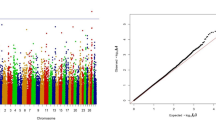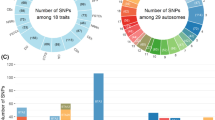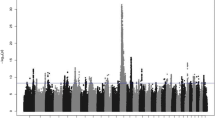Abstract
Genome-Wide Association Studies (GWAS) are used for identification of quantitate trait loci (QTL) and genes associated with several traits. We aimed to identify genomic regions, genes, and biological processes associated with number of total and viable oocytes, and number of embryos in Gir dairy cattle. A dataset with 17,526 follicular aspirations, including the following traits: number of viable oocytes (VO), number of total oocytes (TO), and number of embryos (EMBR) from 1641 Gir donors was provided by five different stock farms. A genotype file with 2093 animals and 395,524 SNP markers was used to perform a single-step GWAS analysis for each trait. The top 10 windows with the highest percentage of additive genetic variance explained by 100 adjacent SNPs were selected. The genomic regions identified in our work were overlapped with QTLs from QTL database on chromosomes 1, 2, 5, 6, 7, 8, 9, 13, 17, 18, 20, 21, 22, 24, and 29. These QTLs were classified as External, Health, Meat and carcass, Production or Reproduction traits, and about 38% were related to Reproduction. In total, 117 genes were identified, of which 111 were protein-coding genes. Exclusively associations were observed for 42 genes with EMBR, and 1 with TO. Also, 42 genes were in common between VO and TO, 28 between VO and EMBR, and four genes were in common among all traits. In conclusion, great part of the identified genes plays a functional role in initial embryo development or general cell functions. The protein-coding genes ARNT, EGR1, HIF1A, AHR, and PAX2 are good markers for the production of oocytes and embryos in Gir cattle.






Similar content being viewed by others
Data availability
The datasets generated and analyzed during this study are available from the corresponding author on reasonable request.
References
Aguilar I, Misztal I, Johnson DL et al (2010) Hot topic: a unified approach to utilize phenotypic, full pedigree, and genomic information for genetic evaluation of Holstein final score. J Dairy Sci 93:743–752. https://doi.org/10.3168/jds.2009-2730
Animal QTL Database—QTLdb (2022) http://www.animalgenome.org/QTLdb. Accessed 10 Apr 2022
Anthony TE, Heintz N (2007) The folate metabolic enzyme ALDH1L1 is restricted to the midline of the early CNS, suggesting a role in human neural tube defects. J Comp Neurol 500:368–383. https://doi.org/10.1002/cne.21179
Anton I, Húth B, Füller I et al (2018) Effect of single-nucleotide polymorphisms on the breeding value of fertility and breeding value of beef in Hungarian Simmental cattle. Acta Vet Hung 66:215–225. https://doi.org/10.1556/004.2018.020
Assou S, Haouzi D, Dechaud H et al (2013) Comparative gene expression profiling in human cumulus cells according to ovarian gonadotropin treatments. Biomed Res Int 2013:1–13. https://doi.org/10.1155/2013/354582
Berry DP, Eivers B, Dunne G, McParland S (2019) Genetics of bull semen characteristics in a multi-breed cattle population. Theriogenology 123:202–208. https://doi.org/10.1016/j.theriogenology.2018.10.006
Bindea G, Mlecnik B, Hackl H et al (2009) ClueGO: a cytoscape plug-in to decipher functionally grouped gene ontology and pathway annotation networks. Bioinformatics. https://doi.org/10.1093/bioinformatics/btp101
Carvalho NS, Daltro DS, Machado JD et al (2021) Genetic parameters and genetic trends of conformation and management traits in Dairy Gir cattle. Arq Bras Med Vet Zootec 73:938–948. https://doi.org/10.1590/1678-4162-12341
Chen H (2022) VennDiagram: generate high-resolution venn and euler plots. R package version 1.7.3. https://CRAN.R-project.org/package=VennDiagram
de Fátima Bretanha Rocha R, Garcia AO, Otto PI, et al (2023) Runs of homozygosity and signatures of selection for number of oocytes and embryos in the Gir Indicine cattle. Mamm Genome. https://doi.org/10.1007/s00335-023-09989-w
Do Nascimento Rangel AH, Araújo TPM, da Costa Lima GF et al (2018) Estimativa de tendências genéticas e fenotípicas para características leiteiras de animais das raças gir e guzerá. Acta Sci Anim Sci. https://doi.org/10.4025/actascianimsci.v40i1.36685
Drum JN, Sartori R, de França e Melo L (2019) New perspectives in assisted reproductive technologies in cattle. Rev Ecuatoriana Cienc Anim 3:85–106
Fanton M, Cho JH, Baker VL et al (2023) A higher number of oocytes retrieved is associated with an increase in fertilized oocytes, blastocysts, and cumulative live birth rates. Fertil Steril 119:762–769. https://doi.org/10.1016/j.fertnstert.2023.01.001
GeneCards: The Human Gene Database (2022) https://www.genecards.org/ Accessed 20 Apr 2022
Gialitakis M, Tolaini M, Li Y et al (2017) Activation of the aryl hydrocarbon receptor interferes with early embryonic development. Stem Cell Rep 9:1377–1386. https://doi.org/10.1016/j.stemcr.2017.09.025
Goldar S, Khaniani MS, Derakhshan SM, Baradaran B (2015) Molecular mechanisms of apoptosis and roles in cancer development and treatment. Asian Pacific J Cancer Prev 16:2129–2144. https://doi.org/10.7314/APJCP.2015.16.6.2129
González-Herrera LG, Pereira RJ, El Faro L, Albuquerque LG (2022) Genetic evaluation of lactation persistency in the Gyr breed by using a two-trait random regression model. Anim Prod Sci 62:216. https://doi.org/10.1071/AN20267
Graf A, Krebs S, Zakhartchenko V et al (2014) Fine mapping of genome activation in bovine embryos by RNA sequencing. Proc Natl Acad Sci 111:4139–4144. https://doi.org/10.1073/pnas.1321569111
Gutierrez-Quintana R, Mellersh C, Wessmann A, et al (2021) Hereditary sensory and autonomic neuropathy in a family of mixed breed dogs associated with a novel RETREG1 variant. J Vet Intern Med 35:2306–2314. https://doi.org/10.1111/jvim.16242
Hsu MI, Wang CW, Chen CH, Tzeng CR (2016) Impact of the number of retrieved oocytes on pregnancy outcome in in vitro fertilization. Taiwan J Obstet Gynecol 55:821–825. https://doi.org/10.1016/j.tjog.2015.05.009
Jaton C, Schenkel FS, Sargolzaei M et al (2018) Genome-wide association study and in silico functional analysis of the number of embryos produced by Holstein donors. J Dairy Sci 101:7248–7257. https://doi.org/10.3168/jds.2017-13848
Jukam D, Shariati SAM, Skotheim JM (2017) Zygotic genome activation in vertebrates. Dev Cell 42:316–332. https://doi.org/10.1016/j.devcel.2017.07.026
Layden AJ, O’Brien KO, Pressman EK et al (2016) Vitamin B12 and placental expression of transcobalamin in pregnant adolescents. Placenta 45:1–7. https://doi.org/10.1016/j.placenta.2016.06.011
Li J, Lu M, Zhang P et al (2020) Aberrant spliceosome expression and altered alternative splicing events correlate with maturation deficiency in human oocytes. Cell Cycle 19:2182–2194. https://doi.org/10.1080/15384101.2020.1799295
Ma L, Cole JB, Da Y, VanRaden PM (2019) Symposium review: genetics, genome-wide association study, and genetic improvement of dairy fertility traits. J Dairy Sci 102:3735–3743. https://doi.org/10.3168/jds.2018-15269
Maere S, Heymans K, Kuiper M (2005) BiNGO: a cytoscape plugin to assess overrepresentation of gene ontology categories in biological networks. Bioinformatics. https://doi.org/10.1093/bioinformatics/bti551
Maiorano AM, Lourenco DL, Tsuruta S et al (2018) Assessing genetic architecture and signatures of selection of dual purpose Gir cattle populations using genomic information. PLoS ONE 13:1–24. https://doi.org/10.1371/journal.pone.0200694
Martins CF (2010) O impacto da transferência de embriões e da fecundação in vitro na produção de bovinos no Brasil. Embrapa Cerrados: INFOTECA-E. https://www.infoteca.cnptia.embrapa.br/infoteca/handle/doc/875061. Accessed 17 Mai 2022
Misztal I, Tsuruta S, Strabel T, et al (2002) BLUPF90 and related programs (BGF90). Commun. No. 28-07
Moore SG, Hasler JF (2017) A 100-year review: reproductive technologies in dairy science. J Dairy Sci 100:10314–10331. https://doi.org/10.3168/jds.2017-13138
Munakata Y, Kawahara-Miki R, Shiratsuki S et al (2016) Gene expression patterns in granulosa cells and oocytes at various stages of follicle development as well as in in vitro grown oocyte-and-granulosa cell complexes. J Reprod Dev 62:359–366. https://doi.org/10.1262/jrd.2016-022
NCBI - National Center for Biotechnology Information (2022) https://www.ncbi.nlm.nih.gov/. Accessed 24 Apr 2022.
Neuwirth E (2022) RColorBrewer: ColorBrewer palettes. R package version 1.1–3. https://CRAN.R-project.org/package=RColorBrewer
Ortega MS (2018) Identification of genes associated with reproductive function in dairy cattle. Anim Reprod 15:923–932. https://doi.org/10.21451/1984-3143-AR2018-0018
Otto PI, Guimarães SEF, Calus MPL et al (2020) Single-step genome-wide association studies (GWAS) and post-GWAS analyses to identify genomic regions and candidate genes for milk yield in Brazilian Girolando cattle. J Dairy Sci 103:10347–10360. https://doi.org/10.3168/jds.2019-17890
Pachoensuk T, Fukuyo T, Wanlada K et al (2020) Pax2a is expressed in oocytes and is responsible for early development and oogenesis in zebrafish. Biochem Biophys Res Commun 533:592–599. https://doi.org/10.1016/j.bbrc.2020.09.059
Panetto JCC, Silva MVGB, Verneque RS, et al (2021) Programa Nacional de Melhoramento do Gir Leiteiro—Sumário Brasileiro de Touros; 4ª Avaliação genômica de touros—Resultado do Teste de Progênie. Embrapa Gado de Leite.
Parker Gaddis KL, Null DJ, Cole JB (2016) Explorations in genome-wide association studies and network analyses with dairy cattle fertility traits. J Dairy Sci 99:6420–6435. https://doi.org/10.3168/jds.2015-10444
Parker Gaddis KL, Dikmen S, Null DJ et al (2017) Evaluation of genetic components in traits related to superovulation, in vitro fertilization, and embryo transfer in Holstein cattle. J Dairy Sci 100:2877–2891. https://doi.org/10.3168/jds.2016-11907
Pereira MA (2019) Análise genética de características de produção in vitro de embriões de doadoras da raça Gir Leiteiro. UNESP
Perez BC, Peixoto MGCD, Bruneli FT, Ramos PVB, Balieiro JCC (2016) Genetic analysis of oocyte and embryo production traits in Guzerá breed donors and their associations with age at first calving. Genet Mol Res 15:15027583. https://doi.org/10.4238/gmr.15027583
R Core Team (2022) ´R: a language and environment for statistical computing. R Foundation for Statistical Computing, Vienna, Austria
de Fátima Bretanha Rocha R, Otto PI, da Silva MVGB et al (2022) Repeatability and random regression models to estimate genetic parameters for oocyte and embryo production in the Gir breed. Anim Prod Sci 62:1661–1670. https://doi.org/10.1071/AN21588
Rodriguez A, Tripurani SK, Burton JC et al (2016) SMAD signaling is required for structural integrity of the female reproductive tract and uterine function during early pregnancy in mice. Biol Reprod 95:44–44. https://doi.org/10.1095/biolreprod.116.139477
Roelofs JB, van Erp-van der Kooij E (2015) Estrus detection tools and their applicability in cattle: recent and perspectival situation. Anim Reprod 12.
Rosen BD, Bickhart DM, Schnabel RD et al (2020) De novo assembly of the cattle reference genome with single-molecule sequencing. Gigascience. https://doi.org/10.1093/gigascience/giaa021
Sadler TW (2005) Embryology of neural tube development. Am J Med Genet Part C Semin Med Genet 135C:2–8. https://doi.org/10.1002/ajmg.c.30049
Sakatani M, Bonilla L, Dobbs KB et al (2013) Changes in the transcriptome of morula-stage bovine embryos caused by heat shock: relationship to developmental acquisition of thermotolerance. Reprod Biol Endocrinol 11:3. https://doi.org/10.1186/1477-7827-11-3
Sbardella AP, Watanabe RN, da Costa RM et al (2021) Genome-wide association study provides insights into important genes for reproductive traits in Nelore cattle. Animals (basel) 11:1386. https://doi.org/10.3390/ani11051386
Shannon P, Markiel A, Ozier O et al (2003) Cytoscape: a software environment for integrated models of biomolecular interaction networks. Genome Res 13:2498–2504. https://doi.org/10.1101/gr.1239303
Sinha PB, Tesfaye D, Rings F et al (2017) MicroRNA-130b is involved in bovine granulosa and cumulus cells function, oocyte maturation and blastocyst formation. J Ovarian Res 10:37. https://doi.org/10.1186/s13048-017-0336-1
Stelzer G, Plaschkes I, Oz-Levi D et al (2016) VarElect: the phenotype-based variation prioritizer of the GeneCards suite. BMC Genom 17:195–206. https://doi.org/10.1186/s12864-016-2722-2
Stephens MA (1986) Tests based on EDF statistics. In: Stephens, MA (1974) EDF statistics for goodness of fit and some comparisons. J Am Stat Assoc 69:730–737. https://doi.org/10.1080/01621459.1974.10480196
Suárez-Vega A, Arranz JJ, Pérez V, et al (2018) Early adipose deposits in sheep: comparative analysis of the perirenal fat transcriptome of Assaf and Churra suckling lambs. Anim Genet 49:605–617. https://doi.org/10.1111/age.12725
TFM-Explorer (2022) Transcription factor matrix explorer—bonsai bioinformatics. https://bioinfo.lifl.fr/tfm-explorer/tfm-explorer.php. Accessed 24 Apr 2022
Thode HC (2002) Testing for normality. Marcel Dekker, New York
Tiezzi F, Parker-Gaddis KL, Cole JB et al (2015) A genome-wide association study for clinical mastitis in first parity US holstein cows using single-step approach and genomic matrix re-weighting procedure. PLoS ONE 10:e0114919. https://doi.org/10.1371/journal.pone.0114919
Turhan A, Pereira MT, Schuler G et al (2021) Hypoxia-inducible factor (HIF1alpha) inhibition modulates cumulus cell function and affects bovine oocyte maturation in vitro†. Biol Reprod 104:479–491. https://doi.org/10.1093/biolre/ioaa196
Turner SD (2018) qqman: an R package for visualizing GWAS results using Q-Q and manhattan plots. J Open Source Softw 3:731. https://doi.org/10.21105/joss.00731
Ulloa SMB, Heinzmann J, Herrmann D et al (2015) Effects of different oocyte retrieval and in vitro maturation systems on bovine embryo development and quality. Zygote 23:367–377. https://doi.org/10.1017/S0967199413000658
Valour D, Hue I, Degrelle S et al (2013) Pre- and post-partum mild underfeeding influences gene expression in the reproductive tract of cyclic dairy cows. Reprod Domest Anim 48:484–499. https://doi.org/10.1111/rda.12113
Vargas G, Neves HHR, Camargo GMF et al (2018) Genome-wide association study and functional analysis of feet and leg conformation traits in Nellore cattle. J Anim Sci 96:1617–1627. https://doi.org/10.1093/jas/sky079
Verardo LL, Silva FF, Lopes MS et al (2016) Revealing new candidate genes for reproductive traits in pigs: combining Bayesian GWAS and functional pathways. Genet Sel Evol. https://doi.org/10.1186/s12711-016-0189-x
Viana JHM (2022) 2021 Statistics of embryo production and transfer in domestic farm animals: a new milestone has been reached: Transfers of IVP embryos were over one million worldwide. Embryo Technol Newsl 40.
Xu P, Ma Y, Wu H, Wang Y-L (2021) Placenta-derived MicroRNAs in the pathophysiology of human pregnancy. Front Cell Dev Biol. https://doi.org/10.3389/fcell.2021.646326
Zhu T, Yuan J, Wang Y et al (2015) MiR-661 contributed to cell proliferation of human ovarian cancer cells by repressing INPP5J expression. Biomed Pharmacother 75:123–128. https://doi.org/10.1016/j.biopha.2015.07.023
Zielak-Steciwko AE, Evans ACO (2016) Genomic portrait of ovarian follicle growth regulation in cattle. Reprod Biol 16:197–202. https://doi.org/10.1016/j.repbio.2016.07.003
Acknowledgements
We thank the farmers who provided data for this study.
Funding
Coordination and Improvement of Higher Level Personnel (CAPES), National Council for Scientific and Technological Development (CNPq)—regarding process 142600/2019-9, Ministério da Ciência Tecnologia e Inovação (MCTI) and Brazilian National Institute of Science and Technology in Animal Science (INCT-CA) provided financial support towards this study.
Author information
Authors and Affiliations
Contributions
JCdCP, MAM, MVBdS, SEFG: conceptualization of the study. RFBR, SEFG: drafted the manuscript. RFBR: performed the experiments and analysis. AOG, MGS, PIO: statistical analyses support. MVBdS, MFM, MAM, JCdCP: bioinformatics technical support. All authors read and approved the final manuscript.
Corresponding author
Ethics declarations
Conflict of interest
The authors declare no conflict of interest.
Ethical approval
Not applicable. Farmers who provided the data adherence to a high standard of veterinary care.
Consent for publication
Not applicable.
Additional information
Publisher's Note
Springer Nature remains neutral with regard to jurisdictional claims in published maps and institutional affiliations.
Supplementary Information
Below is the link to the electronic supplementary material.
Rights and permissions
Springer Nature or its licensor (e.g. a society or other partner) holds exclusive rights to this article under a publishing agreement with the author(s) or other rightsholder(s); author self-archiving of the accepted manuscript version of this article is solely governed by the terms of such publishing agreement and applicable law.
About this article
Cite this article
Rocha, R.d.B., Garcia, A.O., Otto, P.I. et al. Single-step genome-wide association studies and post-GWAS analyses for the number of oocytes and embryos in Gir cattle. Mamm Genome 34, 497–508 (2023). https://doi.org/10.1007/s00335-023-10009-0
Received:
Accepted:
Published:
Issue Date:
DOI: https://doi.org/10.1007/s00335-023-10009-0




